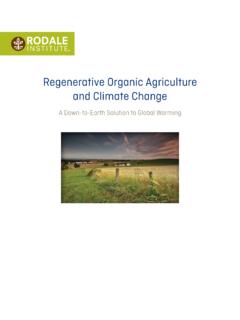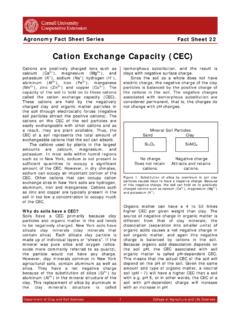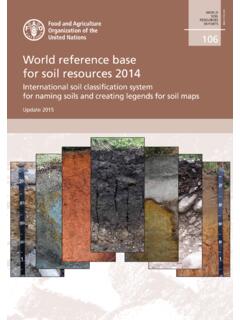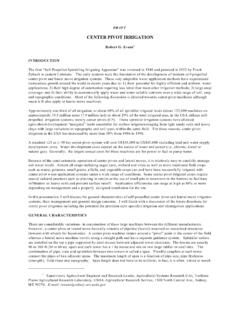Transcription of Mapping Carbon Emissions & Removals for the Land Use, …
1 June 2021 Mapping Carbon Emissions & Removals for the land Use, land -Use Change & Forestry Sector A report of the National Atmospheric Emissions Inventory 2019 This document has been prepared by the UK Centre for Ecology & Hydrology on behalf of the Department for Business, Energy & Industrial Strategy (BEIS) Crown copyright 2021 This publication is licensed under the terms of the Open Government Licence except where otherwise stated. To view this licence, visit or write to the Information Policy Team, The National Archives, Kew, London TW9 4DU, or email: Where we have identified any third-party copyright information you will need to obtain permission from the copyright holders concerned.
2 Any enquiries regarding this publication should be sent to us at: Carbon Emissions and Removals for the land use, land -use change & forestry sector 3 Contents land Use, land -Use Change and Forestry in the National Inventory _____ 4 Categories _____ 4 Activities _____ 6 Forest land _____ 9 soil and Biomass _____ 9 Indirect Drainage _____ 11 Forest Wildfires _____ 12 Emissions from mineral soils due to land -use change: cropland, grassland, settlements ___ 13 Emissions from soils due to drainage, rewetting and management of organic soils: forest, cropland, grassland, wetland, settlement _____ 16 Drainage _____ 16 Peat Extraction _____ 18 Rewetting _____ 19 Emissions from undrained organic soils.
3 Grassland, wetland _____ 21 Estimates of various minor Emissions _____ 22 Non-Forest Biomass _____ 22 Deforestation _____ 25 Cropland Management soil _____ 27 Cropland and Grassland Management Biomass _____ 28 LULUCF Totals _____ 29 Uncertainties _____ 29 Recalculations _____ 31 References _____ 37 Mapping Carbon Emissions and Removals for the land use, land -use change & forestry sector 4 land Use, land -Use Change and Forestry in the National Inventory The Department for Business, Energy and Industrial Strategy (BEIS) takes the lead in the UK in preparing the annual Inventory of Greenhouse Gas Emissions for the United Nations Framework Convention on Climate Change (UNFCCC).
4 BEIS contract Ricardo Energy & Environment (REE) to compile the overall greenhouse gas Emissions inventory and they in turn subcontract the UK Centre for Ecology and Hydrology (UKCEH) and Forest Research (FR) to prepare the data relating to land Use, land -Use Change and Forestry (LULUCF) in the UK. This report is prepared in order to describe the method used to spatially disaggregate the Emissions and Removals in the LULUCF sector to enable the compilation of LULUCF estimates for Local Authorities as part of BEIS s assistance to Local Authorities in tracking progress on decarbonisation.
5 The LULUCF data reported to the annual inventory is prepared in accordance with the reporting requirements of the UNFCCC. In addition, the UK is required to provide reports to the UNFCCC on progress towards its Kyoto Protocol (KP) target following KP reporting requirements. These are substantially different in approach. The data provided in this report are taken from the UNFCCC reporting data set and are consistent with current UK Carbon Budgets approaches. These estimates are made using dynamic models of changes in stored Carbon , driven by land use change data.
6 For forestry, the CARBINE model (developed and run by FR) deals with plant Carbon , dead organic matter, soil Carbon and harvested wood products and is driven by the area of land newly afforested each year, management practices and harvesting. Changes in soil Carbon are driven by estimated time series of land use transitions between grassland, cropland, forest land and settlement land uses. These models, and those for other LULUCF activities, are run for each of the four countries of the UK. Until the 1990-2004 inventory (submitted in 2006) no data were reported in map format at a scale below the devolved administrations (England, Scotland, Wales and Northern Ireland); here we report results from methods to provide estimates of LULUCF Emissions and Removals at the scale of local authority (LA) within the UK for the 2019 inventory year (published in 2021).
7 The LULUCF Sector differs from other sectors in the Greenhouse Gas Inventory in that it contains both sources and sinks of greenhouse gases. The sources, or Emissions to the atmosphere, are given as positive values; the sinks, or Removals from the atmosphere, are given as negative values. Categories The IPCC Guidelines for National Greenhouse for National Greenhouse Gas Inventories (IPCC 2006, IPCC 2014) describes a uniform structure for reporting Emissions and Removals of greenhouse gases. This format for reporting can be seen as land based ; all land in the country must be identified as having remained in one of six classes since a previous survey, or as having changed to a different (identified) class in that period.
8 The six land classes are A: Forest land , B: Cropland, C: Grassland, D: Wetlands, E: Settlements and F: Other land . There is a seventh category for the pool of harvested wood products, category G. Mapping Carbon Emissions and Removals for the land use, land -use change & forestry sector 5 The IPCC (2006) guidelines for LULUCF accommodate differences in national land -use classification systems. Emissions from the drainage and rewetting of peatlands, included for the first time in the 1990-2019 LULUCF inventory (Brown et al.)
9 2021), are reported under all LULUCF land use categories. These are compiled following guidance for estimating Emissions from inland organic soils set out in chapters 2 and 3 of the 2013 IPCC Wetlands Supplement, and employing the Tier 2 methodological approach for implementation described in the BEIS-funded wetlands report (Evans et al. 2017), with additional updates summarised in section of the National Inventory Report Annexes (Brown et al. 2021). Emissions from drained and rewetted organic soils have been allocated to their local authorities in the UK using the peat condition Mapping outputs from Evans et al.
10 (2017). The majority of peatland area is reported in the Grassland category, which includes semi-natural bog categories, extensive and intensive grassland, and rewetted bog or fen from semi-natural bog and intensive and extensive grassland. Emissions from active peat extraction (onsite, and off-site for horticultural peat1), as well as organic soils affected by historical peat extraction are reported under Wetlands. Naturally occurring Emissions and Removals from pristine areas of bog and fen, and rewetted bog or fen from Forest land , Cropland, peat extraction, and pre-1990 rewetted fen are now included in LULUCF reporting under Wetlands.
















